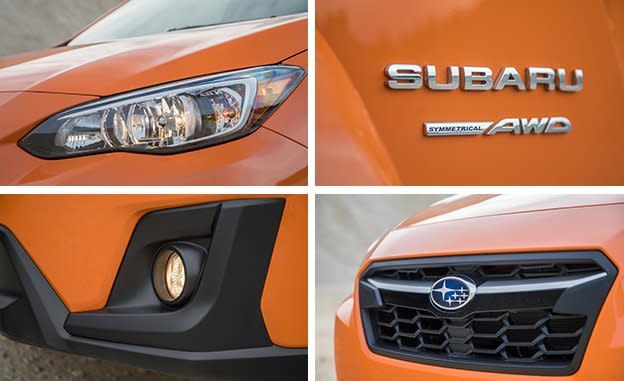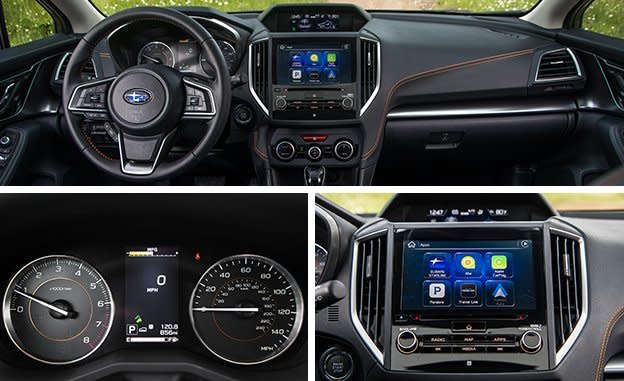2018 Subaru Crosstrek

Panning through the vast array of compact crossovers in search of a golden high-riding hatch can return mixed results. Just like pioneers rushing to the Black Hills at the first rumors of gold, consumers flock to dealerships, purchasing the mini-utes turned out by factory mines at record rates. Subaru’s Crosstrek has been a favorite of those prospecting for a little more ride height, four-wheel-drive capability, and decent gas mileage at a low price, and the redesigned 2018 model looks to burnish that appeal.
The second-generation Crosstrek once again is essentially a jacked-up Impreza hatchback, and its exterior shares much with its lower-riding sibling. Front and rear fascias along with the wheel arches and rocker panels receive plastic cladding to give the Crosstrek a more rugged look. Like the Impreza, the Crosstrek rides on Subaru’s new Global Platform. It features a refined front-strut suspension with bracing for additional lateral support, as well as strengthened mounting points. The rear multilink suspension has been revised as well and bolts to a beefier rear subframe. Both the front and rear anti-roll bars also have been relocated.

The new underpinnings provided outstanding ride comfort and compliance during our drive in western South Dakota, and we found that body roll was adequately contained for a crossover. Minor imperfections in the road surface went largely unnoticed, with only major impacts and washboard dirt roads disrupting the chassis. Although the steering is now quicker, going from a 16.0:1 to a 13.0:1 ratio, the effort remains light, and the rack offers little communication—but that’s something buyers aren’t likely to be concerned about. The lack of feedback might bother those keen to know about the new Crosstrek’s brake-based active torque vectoring, which helps seek apexes. A revised master cylinder and brake booster make for a firm brake pedal that is linear and easy to modulate.
Quieter and Roomier
Subaru has reduced the number of pass-throughs in the firewall in an effort to mitigate the amount of engine noise that reaches the cabin. A sound-insulated windshield on Premium and Limited trims and thicker glass elsewhere combine with additional sound-deadening material to create a serene environment. The slim A-pillars and large front glass area make for excellent visibility, while the seats provide all-day comfort. Interior volume grows to 101 cubic feet from 98 in the outgoing generation.
These gains largely come from increasing the width, by 1.1 inches in the front and 1.3 inches in the rear, allowing the front seats to be placed farther apart and increasing hiproom. There’s also an additional 1.1 inches of rear-seat legroom, but the seat-bottom cushion is on the short side for full-size adults. Cargo volume also benefits from the swollen body, with the Crosstrek capable of swallowing 21 cubic feet of gear with the seats upright (one cube less than previously) and 55 with the seatbacks folded, up three cubes from before. Loading that cargo should be easier, too, as the width of the hatch opening has been increased by four inches and the distance between the wheelhouses is larger, allowing for bulkier cargo.

This Four Falls Flat
Like the Impreza, the Crosstrek is propelled by a revised 2.0-liter flat-four. The engine is now fed via direct injection and has a strengthened block to handle a bump in compression, up to 12.5:1 from 10.5:1. Subaru claims the engine is 80 percent new and 26 pounds lighter. Output is little changed, however: 152 horsepower at 6000 rpm versus 148 previously, while peak torque remains the same at 145 lb-ft but occurs 200 rpm earlier at 4000 rpm. Revised throttle mapping has eliminated the jumpy tip-in that plagued the previous Crosstrek. The engine is smooth all the way to redline, but don’t expect neck-snapping acceleration. Our drive took place at 4000 feet of elevation, and accelerating to cruising speed seemed to take longer than the construction of Mount Rushmore. The engine needs a turbo, especially this far above sea level.
Delivering the output to the standard all-wheel-drive system is one of two transmissions: a six-speed manual gearbox in the base and Premium trims and a continuously variable automatic that’s available across the line and is standard on the Limited. (The CVT is a $1000 option on the base and Premium trims.) We applaud Subaru for offering a stick shift, even though the take rate is expected to be only about 7 percent. The clutch pedal has good takeup, and the nicely weighted shifter travels through its gates with ease. As for the CVT, it has a greater ratio spread for improved efficiency, and it now incorporates seven stepped, predetermined ratios (controllable via paddle shifters) to mimic traditional gearshifting and mitigate the rubber-band sensation and redline moaning.
It breaks our hearts to admit this, but the CVT is better at accessing what little power the engine makes. Although the CVT whines as the redline nears, the stepped ratios keep the rpm in the powerband. In the manual, the four-banger hangs the revs between shifts, shifting quickly disrupts the driveline, and frequent downshifts are necessary during spirited driving to locate any signs of life. At least the sleepy engine and the CVT provide an upside in the form of fuel efficiency. Crosstreks equipped with the automatic earn an EPA combined fuel-economy rating of 29 mpg, versus 25 with the stick shift.

In the manual-equipped models, a viscous limited-slip center differential restricts the torque delivery to a 50/50 front-to-rear split. The CVT connects to an electronically controlled differential, making the torque split continuously variable. Also standard for the first time on the CVT-equipped Crosstreks is Subaru’s X-Mode off-road system. Working only at low speeds, it locks the transmission into lower ratios and increases clutch pressure in the differential to smooth power distribution when climbing hills. It also ups the traction- and stability-control systems’ sensitivity in slippery situations, and provides hill-descent control on steep slopes. We sampled X-Mode in a rock quarry, where it—plus the Crosstrek’s 8.7 inches of ground clearance—performed as promised, helping the Subie climb the loose rock with ease as power was delivered to the appropriate wheel when needed. Using the hill-descent control, we clambered down slopes without needing to touch the brake pedal.
Pricing for the base Crosstrek starts at $22,710, which includes a 6.5-inch touchscreen infotainment system with Apple CarPlay and Android Auto capability, a rearview camera, and 17-inch wheels. For $23,510, the mid-level Premium adds heated front seats and exterior mirrors, automatic headlights, fog lamps, orange stitching on the cloth interior, a leather-wrapped steering wheel and shifter, and various interior lighting upgrades. Available on CVT-equipped Premium models is a power sunroof and Subaru’s camera-based active-safety package, EyeSight, which includes adaptive cruise control, automated pre-collision braking, lane-departure warning, lane-keeping assist, blind-spot monitoring, rear cross-traffic alert, adaptive fog lights, and a 4.2-inch display tucked into the instrument cluster. Going all in for the Limited, at $27,210, brings 18-inch wheels, a power driver’s seat, LED headlights, an upgraded 8.0-inch touchscreen with satellite radio and optional navigation, leather seats, and faux-carbon-fiber trim. The aforementioned sunroof and EyeSight package are optional here, too, along with automated reverse braking, high-beam assist, and a booming eight-speaker Harman/Kardon stereo.
With a solid foundation, a comfortable ride, off-the-beaten-path ability, and affordable pricing, the Subaru Crosstrek is a formidable player in the compact-crossover market. If you’re holding out for a turbocharged model, don’t: Subaru has no issues selling the ’Trek with the sluggish powertrain. The company delivered 17,000 of these new second-generation Crosstreks in the first month of availability in Japan—equal to a typical month of sales there of Subaru’s entire lineup. If that’s an indicator of what’s to come in North America, Subaru will have no problem lining its pockets with even more gold.
Specifications >
VEHICLE TYPE: front-engine, all-wheel-drive, 5-passenger, 4-door hatchback
BASE PRICE: Base, $22,710;
Premium, $23,510;
Limited, $27,210
ENGINE TYPE: DOHC 16-valve flat-4, aluminum block and head, direct fuel injection
Displacement: 122 cu in, 1995 cc
Power: 152 hp @ 6000 rpm
Torque: 145 lb-ft @ 4000 rpm
TRANSMISSIONS: 6-speed manual, continuously variable automatic with manual shifting mode
DIMENSIONS:
Wheelbase: 104.9 in
Length: 175.8 in
Width: 71.0 in Height: 63.6 in
Passenger volume: 97-101 cu ft
Cargo volume: 21 cu ft
Curb weight (C/D est): 3100–3300 lb
PERFORMANCE (C/D EST):
Zero to 60 mph: 7.9-10.1 sec
Zero to 100 mph: 26.7-30.2 sec
Standing ¼-mile: 16.4-17.8 sec
Top speed: 120 mph
FUEL ECONOMY (C/D EST):
EPA combined/city/highway driving: 25–29/23–27/29–33 mpg

